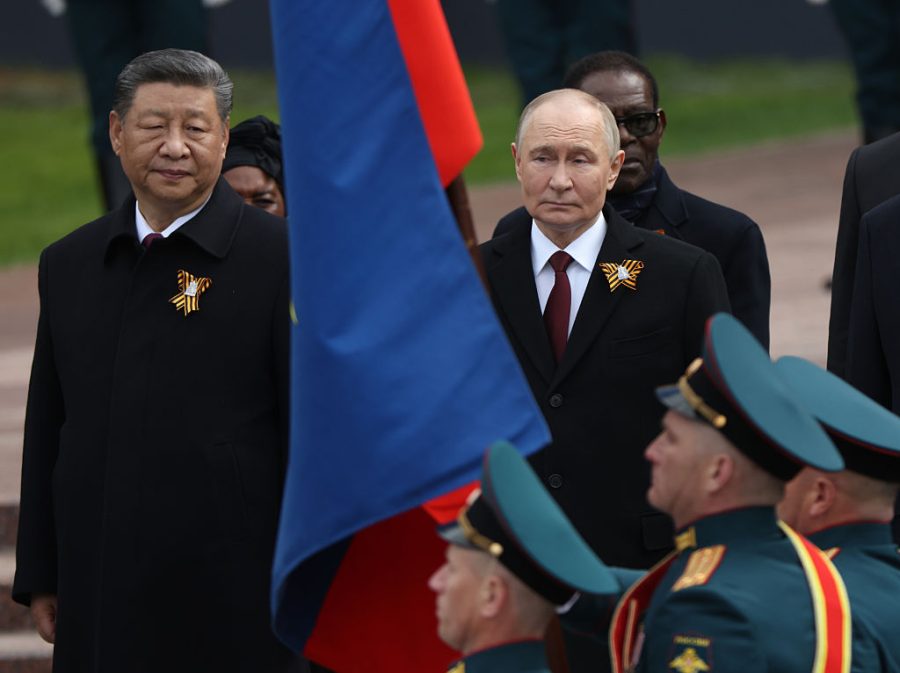This week’s Nato summit could not come at a more pivotal moment. As recent months have shown, the challenges to contemporary global security are no longer limited to the individual threats posed by Moscow, Tehran, or Pyongyang. What makes the current situation even more concerning for the West is the multiple threats posed by the heightened bilateral and trilateral collaborations between these actors, alongside those with Beijing. Whilst the so-called CRINK (China, Russia, Iran, and North Korea) does not yet constitute any formal strategic alliance, it would be naïve and dangerous to dismiss their ties as merely superficial.
On his visit to the United Kingdom on Monday, Volodymyr Zelensky called Russia, Iran, and North Korea a ‘coalition of murderers’ after Russian drones and ballistic missiles struck Kyiv hours after his arrival in London. Ukrainian intelligence reported that half of the 352 drones used were Iranian Shahed drones, and many of the ballistic missiles were from North Korea.
The authoritarian axis between Russia, Iran, North Korea, and China will be just one global security concern
Within this ‘coalition’, there is ample room for China, which enables Moscow’s war through providing dual-use technologies to Russia. Akin to its Russian counterpart, Beijing has also violated United Nations sanctions which it previously supported. Tens of thousands – if not more – of North Korean workers remain in China and Russia, and for all Beijing’s supposed nausea at Pyongyang’s rapprochement with Moscow, such emesis is not severe enough to prevent the middle kingdom from aiding its naughty nuclear neighbour by smuggling oil and petroleum.
Since Russia’s initial invasion of Ukraine in February 2022, mutual support between China, North Korea, Russia and Iran have gone beyond mere words of affirmation. Whether the development of Russian weapons factories in China; the cash-for-munitions (and manpower) exchange between Moscow and Pyongyang; or the sharing of ballistic missile technology between Pyongyang and Tehran, bilateral cooperation has reached new heights. Who can forget when Russia and North Korea signed a ‘comprehensive strategic partnership treaty’ on 19 June last year, within which was contained a mutual defence clause? Or when this year began with Moscow and Tehran signing a treaty of the same name, albeit this time lacking such a commitment to mutual defence?
These four countries do not possess identical interests or ideologies: one need only compare the theocracy of Iran with the atheistic nature of China and North Korea. Nevertheless, their unity in their opposition to the United States and the US-led international order would be perilous to ignore.
After the first week of the current Israeli-Iranian conflict, Putin mentioned that Russia had no intention of providing military assistance to Iran. But when the Russian President hosted the Iranian Foreign Minister, Abbas Araqchi, yesterday, days after the US’s successful precision-guided strikes on three Iranian uranium enrichment sites, he made clear how the attack had ‘no basis and no justification’. Even if Russia does not get involved directly in supporting Iran, we all know which team it bats for.
For all their differences, these states can also learn from each other. The US’s air strikes on Fordow, Natanz, and Isfahan have only underscored how Iran is the weakest amongst this quartet of chaos. Yet, Trump’s hardly unsubtle hint at regime change in Iran will do little to convince what is left of the crumbling Iranian regime to renege on their nuclear aspirations. Tehran needs only to look nearly four thousand miles eastwards, to Pyongyang, for inspiration.
As world leaders meet today for the two-day Nato summit in The Hague, the authoritarian axis between Russia, Iran, North Korea, and China will be just one regional and global security concern during a time of ‘polycrisis’ across the globe. Despite such interconnectedness, out of the so-called Indo-Pacific Four (Japan, South Korea, Australia, New Zealand), only the New Zealand Prime Minister, Christopher Luxon, has agreed to attend the summit. The leaders of the other three states, including the newly-elected South Korean President, Lee Jae-myung, have opted to send senior officials (in South Korea’s case, National Security Advisor, Wi Sung-lac), in their places.
That three out of the four leaders have chosen to sit out this week’s gathering – which they had attended (as non-Nato members) since 2022 – could be seen as a snub to US President Donald Trump, in disapproval of his intervention in Iran. But Tokyo, Seoul, and Canberra may also be motivated by great power politics.
If no bilateral discussion with Trump – who has imposed sweeping tariffs on all four Indo-Pacific states – is on the cards, then summitry remains firmly off the cards. It is perhaps ironic that the Japanese Prime Minister, Ishiba Shigeru, has chosen not to attend what would have been his first Nato Summit, given his past calls for an ‘Asian Nato’. Japan has also been hesitant to support the US’s stance towards Iran, not least given Tokyo’s dependence on the Middle Eastern region for over 90 per cent of its crude oil imports. For a country whose economy is hardly blossoming, any closure to the Straits of Hormuz – which Tehran has threatened – will rub further salt into Tokyo’s economic wounds in addition to causing catastrophic global impacts.
One of the nicknames bestowed upon the loquacious former Japanese prime minister, Junichiro Koizumi, was Nato: ‘no action, talk only’. With a coalition of anti-Western states strengthening their bilateral – if not multilateral – ties, the need for talking to lead to action has never been greater. Last night’s ceasefire between Israel and Iran lasted barely a few hours, and if Iran is successful, a world of nine nuclear-armed states may soon get its tenth member. And by then, who knows how the other rogue states will seek to benefit from the newest member of the nuclear club.







Comments